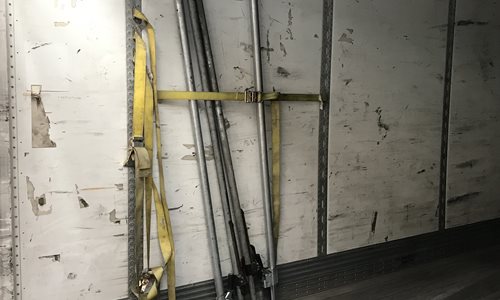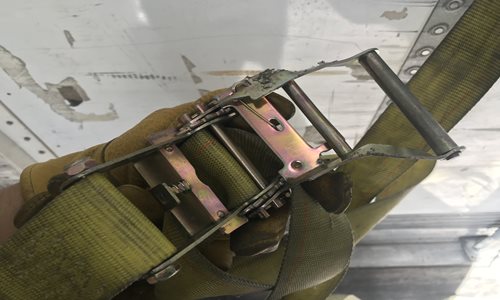We all see it out there, from time to time flatbedders poking fun at reefer and van drivers about “slapping it in and swinging the doors shut”! All kidding aside, the job of cargo securement is serious business and should not be taken lightly. Whether it is chains and binders or bars and straps, we all have tools of the trade we use to secure our freight while it is in transit. What we do with those tools when they’re not in use is important too, so that they don’t become a hazard going down the road.
Flatbed drivers have the most securement tools I usually see out there, being that they haul some of the more odd-shaped loads. A flatbed driver can go from hauling a truckload of ladders to hauling a sensitive load in need of tarping in a moment’s notice, if prepared with the right securement items. This is why they typically have large tool boxes on the trailers and some back of cab storage at times too, that enable them to carry these numerous items for their varying load types. Being a van guy myself, I will say it is much simpler for van and reefer guys!
Though I do not have to carry corner braces, chains and binders for my van freight, I do have quite an assortment of blocks, nails, straps and most recently bars. Never one to like carrying bars, I have inherited them from a shipper that likes to put them with their loads instead of straps and I get to keep them at the receiver end. Though a large toolbox might lend itself to helping organize this stuff, it is not typically something you see a lot of van and reefer trailers equipped with. Likewise you may see bar racks on the back of cabs, but not having spec’d one from the factory because I usually didn't prefer to carry them, I am not one to favor drilling anything aftermarket into the body of my cab unless absolutely necessary to put one in. Due to this, I have had great success with my own method of keeping the regularly required amount of cargo securement items right inside the trailer, closet to where I need them most.

I guess you could say I “Jimmy Rigged” my own rack of sorts inside the tail of the trailer that eliminates the need of having to go outside for my necessary bars, or a couple straps, or any combo of either. Sure I have to keep an eye that none of them “grow legs” and walk away at my shippers and receivers, but using this method I have had great success and even a couple shipper comments that they liked having them organized in the back like this because they were just able to grab a bar and slap it across the back for me without even having to ask. It was an idea I had when I was frequenting a shipper that would make me leave two straps or two bars in the back before loading, which I guess started to accumulate into the 4 bars and 3 straps I keep back there today, along with 7 other straps I have rolled up in the underseat compartment in my Freightliner Cascadia.

Though I may not hold the award for most cargo securing tools onboard my truck, I know the importance of keeping things secure when not in use, while still making sure they are easily accessible. This solution works well for me because I do not haul any wall-to-wall cubed-out loads and have the room to keep these back there and out of the way, so this may not be the best solution for everyone. I like it so much, I may soon even look at a more permanent in-trailer solution that works with my E-track. Next time you have to grab an iced over, dirty load lock off the back of your cab though, remember this little trick and you may just find yourself having a new way to avoid some of those pains of storing these devices out in the elements. Keep an eye out for those “wall riders” though, as occasionally you may find they’ve rubbed a ratchet right off one of your straps or bent a bar, like my picture below! Just like a flatbedder storing their expensive items in a toolbox to protect them, use your own “dry box” to store them safely as well!
